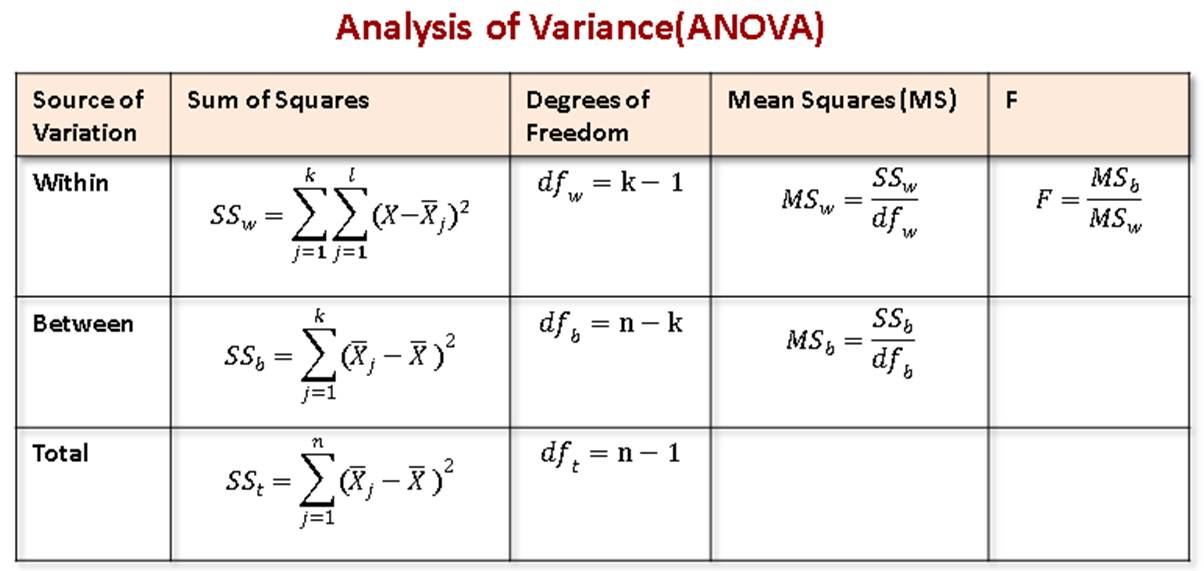Jan 3, 2024Analysis of Variance (ANOVA) is a statistical method used to test differences between two or more means. It is similar to the t-test, but the t-test is generally used for comparing two means, while ANOVA is used when you have more than two means to compare.
Analysis of variance (anova) | PPT
of variance. Thus the procedures for general analysis of variance in SAS/STAT are considered to be those that can fit statistical models containing factors, whether the data are experimental or observational. Some procedures for general analysis of variance have a statistical estimation principle that gives rise to a sum

Source Image: bookdown.org
Download Image
Analysis of variance (ANOVA) is a collection of statistical models and their associated estimation procedures (such as the “variation” among and between groups) used to analyze the differences among means. ANOVA was developed by the statistician Ronald Fisher.ANOVA is based on the law of total variance, where the observed variance in a particular variable is partitioned into components

Source Image: numerade.com
Download Image
BMS404-Ch6Fall19 – biostatistics – Chapter 6 ANALYSIS OF VARIANCE ANOVA 6 One Way (One Factor) ANOVA – Studocu
ANOVA 1: Calculating SST (total sum of squares) ANOVA 2: Calculating SSW and SSB (total sum of squares within and between) ANOVA 3: Hypothesis test with F-statistic. Analysis of variance, or ANOVA, is an approach to comparing data with multiple means across different groups, and allows us to see patterns and trends within complex and varied

Source Image: enago.com
Download Image
In The Analysis Of Variance Procedure Anova Factor Refers To
ANOVA 1: Calculating SST (total sum of squares) ANOVA 2: Calculating SSW and SSB (total sum of squares within and between) ANOVA 3: Hypothesis test with F-statistic. Analysis of variance, or ANOVA, is an approach to comparing data with multiple means across different groups, and allows us to see patterns and trends within complex and varied
Expert Answer 100% (1 rating) Step 1 In the analysis of variance procedure (ANOVA), “factor” refers to the categorical variable, which is… View the full answer Final answer Previous question Next question Not the exact question you’re looking for? Post any question and get expert help quickly. Start learning
How to Choose the Right Statistical Test | Types and Examples
Expert-verified 100% (5 ratings) Step 1 The correct answer is ( b). the independent variable. ⇒ In the analysis of variance ( A N O V A), a facto… View the full answer Step 2 Unlock Answer Unlock Previous question Next question Not the question you’re looking for? Post any question and get expert help quickly. Start learning
Two-way ANOVA • Simply explained – DATAtab

Source Image: datatab.net
Download Image
Analysis of variance (anova) | PPT
Expert-verified 100% (5 ratings) Step 1 The correct answer is ( b). the independent variable. ⇒ In the analysis of variance ( A N O V A), a facto… View the full answer Step 2 Unlock Answer Unlock Previous question Next question Not the question you’re looking for? Post any question and get expert help quickly. Start learning

Source Image: slideshare.net
Download Image
Analysis of variance (anova) | PPT
Jan 3, 2024Analysis of Variance (ANOVA) is a statistical method used to test differences between two or more means. It is similar to the t-test, but the t-test is generally used for comparing two means, while ANOVA is used when you have more than two means to compare.

Source Image: slideshare.net
Download Image
BMS404-Ch6Fall19 – biostatistics – Chapter 6 ANALYSIS OF VARIANCE ANOVA 6 One Way (One Factor) ANOVA – Studocu
Analysis of variance (ANOVA) is a collection of statistical models and their associated estimation procedures (such as the “variation” among and between groups) used to analyze the differences among means. ANOVA was developed by the statistician Ronald Fisher.ANOVA is based on the law of total variance, where the observed variance in a particular variable is partitioned into components

Source Image: studocu.com
Download Image
How to Perform Analysis of Variance (ANOVA) – Step By Step Procedure – The Genius Blog
The specific test considered here is called analysis of variance (ANOVA) and is a test of hypothesis that is appropriate to compare means of a continuous variable in two or more independent comparison groups. For example, in some clinical trials there are more than two comparison groups.

Source Image: kindsonthegenius.com
Download Image
Chapter 9 Analysis of Variance (ANOVA) | Introduction to Statistical Methodology, Second Edition
ANOVA 1: Calculating SST (total sum of squares) ANOVA 2: Calculating SSW and SSB (total sum of squares within and between) ANOVA 3: Hypothesis test with F-statistic. Analysis of variance, or ANOVA, is an approach to comparing data with multiple means across different groups, and allows us to see patterns and trends within complex and varied

Source Image: bookdown.org
Download Image
Analysis of Variance (ANOVA), Overview, Purpose
Expert Answer 100% (1 rating) Step 1 In the analysis of variance procedure (ANOVA), “factor” refers to the categorical variable, which is… View the full answer Final answer Previous question Next question Not the exact question you’re looking for? Post any question and get expert help quickly. Start learning

Source Image: ebrary.net
Download Image
Analysis of variance (anova) | PPT
Analysis of Variance (ANOVA), Overview, Purpose
of variance. Thus the procedures for general analysis of variance in SAS/STAT are considered to be those that can fit statistical models containing factors, whether the data are experimental or observational. Some procedures for general analysis of variance have a statistical estimation principle that gives rise to a sum
BMS404-Ch6Fall19 – biostatistics – Chapter 6 ANALYSIS OF VARIANCE ANOVA 6 One Way (One Factor) ANOVA – Studocu Chapter 9 Analysis of Variance (ANOVA) | Introduction to Statistical Methodology, Second Edition
The specific test considered here is called analysis of variance (ANOVA) and is a test of hypothesis that is appropriate to compare means of a continuous variable in two or more independent comparison groups. For example, in some clinical trials there are more than two comparison groups.